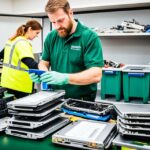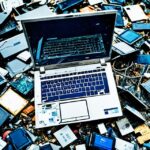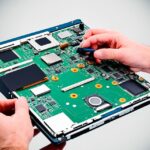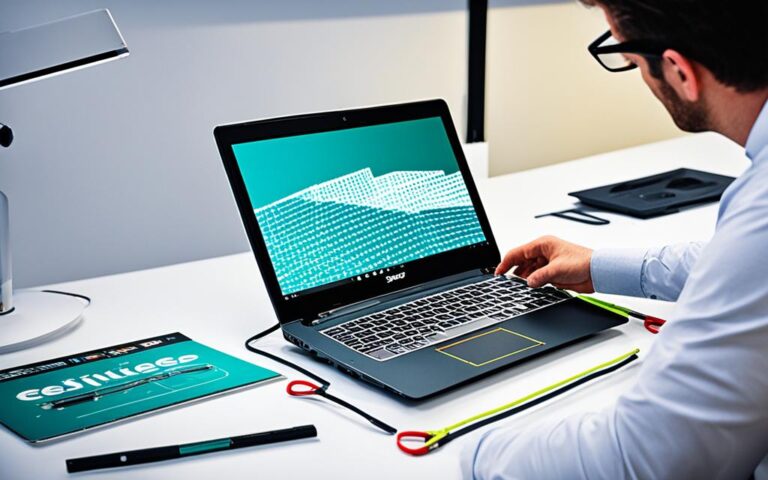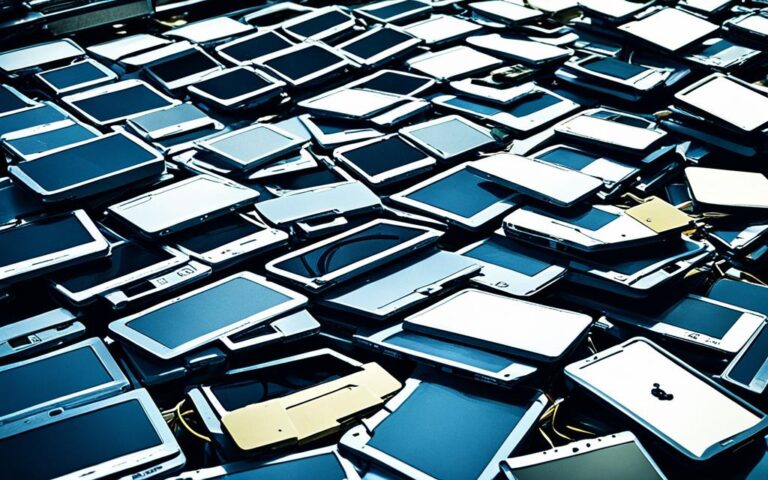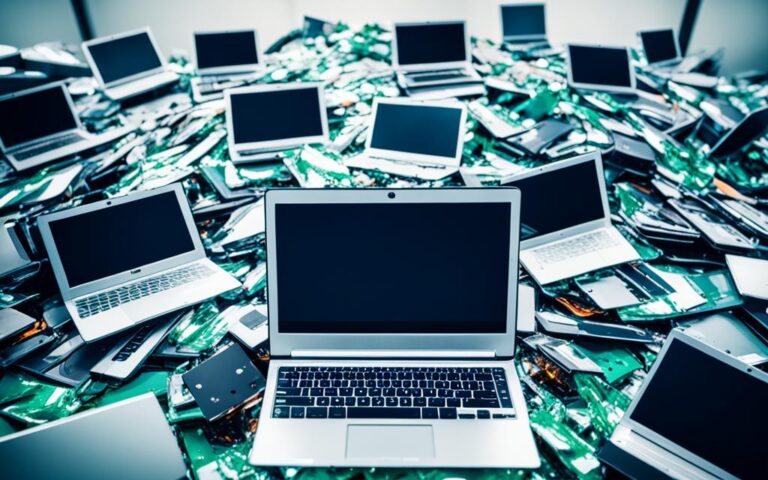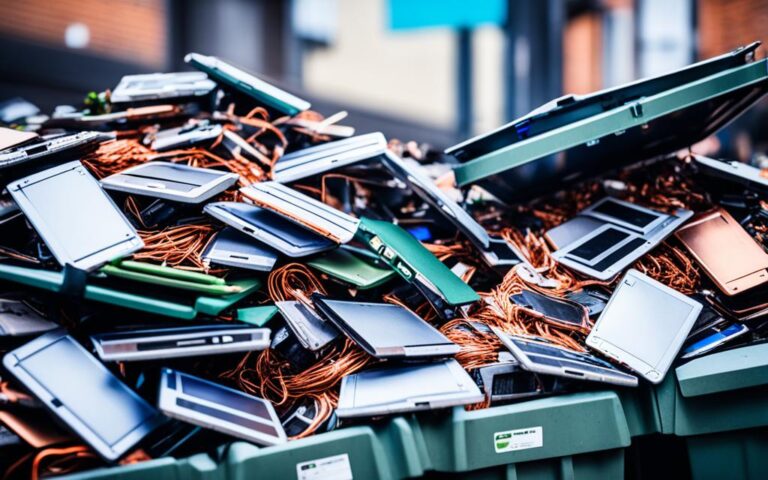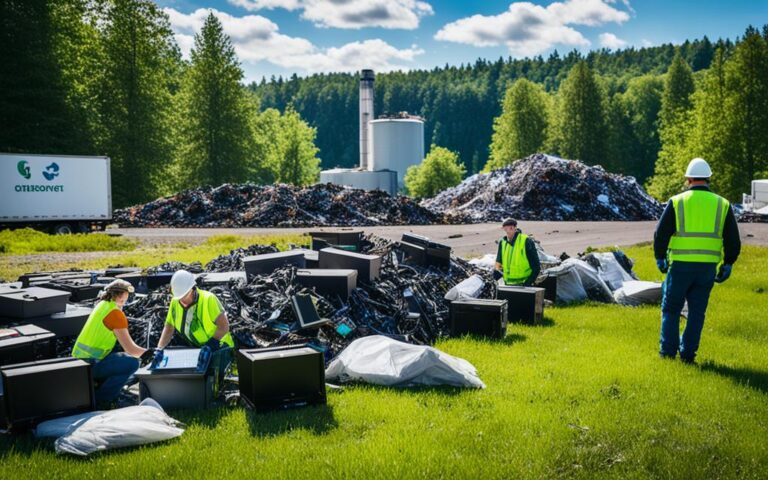The Role of Laptop Recycling in the Tech Refurbishment Industry
Laptop recycling plays a crucial role in the tech refurbishment industry, promoting sustainability and technology reuse across the UK. With the increasing concern about electronic waste and the environmental and security risks associated with improper disposal, laptop recycling has become essential. By recycling laptops, valuable materials can be recovered, hazardous waste can be properly disposed of, and refurbishment opportunities can be explored to extend the lifespan of these devices. This article explores the various aspects of laptop recycling in the tech refurbishment industry and its contribution to a circular economy in the UK.
WEEE Recycling: Reducing Landfill Impact and Promoting Reuse
Waste Electrical and Electronic Equipment (WEEE) recycling is crucial in reducing the impact of electronic waste on landfills and promoting reuse. Globally, an estimated 49.8 million tonnes of WEEE end up in landfills each year, with a significant portion being exported to countries like China, India, and Ghana.
By recycling laptops and other electronic devices, valuable materials such as plastic, metals, and glass can be recovered, even if the equipment is beyond repair. Additionally, batteries, which are often filled with hazardous chemicals, can be recycled.
WEEE recycling allows for the responsible management of electronic waste and contributes to the circular economy by extracting value from discarded devices.
Confidential Destruction: Protecting Data and Extending the Lifespan of Hard Drives
Confidential destruction is a crucial aspect of laptop recycling, especially when it comes to hard drives. Improper disposal of hard drives can lead to data breaches and sensitive information falling into the wrong hands. To ensure data security, recyclers employ advanced software like Blancco, which effectively wipes hard drives to ensure that no data can be leaked.
This process allows for the repair and refurbishment of hard drives, extending their lifespan and preventing them from ending up in e-waste landfills. By securely erasing data and wiping hard drives, recyclers can confidently refurbish these devices for future use, reducing the need for new manufacturing and minimizing environmental impact.
In addition to protecting data, the recycling of hard drives plays a significant role in the responsible management of hazardous materials. Hard drives contain valuable metals such as aluminum, copper, and gold, which can be recovered through the recycling process. The separation and recovery of these metals not only safeguard the environment but also reduce the dependency on mining for sourcing these finite resources.
The environmental benefits of hard drive recycling
By properly recycling hard drives, the tech refurbishment industry contributes to the circular economy, minimizing waste and maximizing resource utilization. Here are some key environmental benefits:
- Reduction in hazardous materials in landfills
- Conservation of natural resources through metal recovery
- Reduction in energy consumption and carbon emissions associated with manufacturing new hard drives
The economic and security advantages of proper hard drive disposal
Beyond the environmental benefits, proper hard drive disposal also offers economic and security advantages:
- Data security: Confidential destruction ensures that sensitive information remains protected, mitigating the risk of data breaches.
- Extended lifespan: Refurbishing and reusing hard drives prolong their useful life, resulting in cost savings and reduced electronic waste.
- Legal compliance: Responsible hard drive disposal helps businesses comply with data protection and environmental regulations, avoiding potential fines and penalties.”
Overall, confidential destruction and hard drive recycling are essential components of laptop recycling that promote data security, extend the lifespan of hard drives, and contribute to a sustainable and circular economy.
Hazardous WEEE: Disposal Challenges and the Need for Design Innovation
Electronic devices categorized as hazardous present significant disposal challenges due to the presence of chemicals that can harm the environment and human health. Items such as fridges and freezers may contain ozone-depleting substances, while older televisions and computer monitors with cathode ray tubes can cause damage through glass shards. Additionally, capacitors and batteries often contain toxic chemicals.
Proper disposal and recycling of hazardous WEEE (Waste Electrical and Electronic Equipment) are crucial to prevent these harmful substances from ending up in landfills, where they can pollute soil and groundwater. The circular economy highlights the need for design innovation to create products that are easily repairable, refurbished, reused, or recycled, minimizing the reliance on disposal as the sole option.
The Challenges of Hazardous WEEE Disposal
Disposing of hazardous WEEE poses a range of challenges, including:
- Ensuring safe handling and transportation to prevent chemical leaks during disposal
- Identifying and separating hazardous components from electronic devices
- Complying with regulations and laws governing the disposal of hazardous materials
Moreover, the recycling process for hazardous WEEE requires specialized facilities equipped to handle the proper extraction and treatment of toxic substances.
The Role of Design Innovation
Design innovation plays a crucial role in addressing the challenges posed by hazardous WEEE disposal. By creating products that are easier to repair and dismantle, manufacturers can facilitate the recycling and refurbishment process, ensuring the proper handling of hazardous materials. Additionally, design innovation can promote the use of safer materials that are less harmful to the environment and human health, reducing the risks associated with hazardous electronic waste.
“Design innovation is essential in creating sustainable electronic products that minimize environmental impacts and maximize resource recovery.” – GreenTech Solutions
Integrating circular design principles can also aid in reducing the generation of hazardous WEEE. By designing for longevity, modularity, and ease of repair, products can have an extended lifespan and be refurbished or upgraded instead of being disposed of as electronic waste.
Examples of Hazardous WEEE Components
| Electronic Device | Hazardous Component |
|---|---|
| Fridges and Freezers | Ozone-depleting substances |
| Older Televisions and Computer Monitors | Cathode Ray Tubes (CRTs) |
| Capacitors and Batteries | Toxic chemicals |
Note: This table provides examples of hazardous components found in common electronic devices. It is not an exhaustive list.
Design innovation and responsible disposal of hazardous WEEE are essential to mitigate environmental and health risks associated with electronic waste. Through the circular economy and collaborative efforts among manufacturers, consumers, and recycling facilities, we can strive for a more sustainable future, where hazardous WEEE is effectively managed and valuable resources are recovered.
The Enviro Waste Process: Responsible Collection and Resource Recovery
The Enviro Waste process is a prime example of responsible collection and resource recovery in laptop recycling. When collected from customers, items are brought back to their facilities for evaluation. Their dedicated IT department runs diagnostics to identify any repairable items, ensuring that no potential resources go to waste. If an item is found to be repairable, the necessary repairs are promptly made, and the item is thoroughly cleaned up.
If an item is deemed beyond repair, it is skillfully stripped down to its component parts. Valuable and useful components are carefully stored for future use in building “Frankenstein Laptops,” ensuring that maximum value is extracted from every scrap. As for the components that cannot be repurposed, they are sent for recycling, ensuring responsible disposal and contributing to a sustainable circular economy.
This image visually represents the Enviro Waste process, showcasing the responsible collection and resource recovery techniques employed in their laptop recycling operations.
The recycling process at Enviro Waste also involves the recovery of precious metals from the discarded laptops. These recovered materials are then sold, further adding value to the circular economy. By adopting an efficient collection process, carrying out necessary repairs, and responsibly recovering resources, Enviro Waste demonstrates how laptop recycling can be a sustainable and environmentally friendly practice.
Cost Savings and Environmental Responsibility: The Benefits of IT Recycling
IT recycling offers numerous benefits to businesses, including cost savings and environmental responsibility. By participating in IT recycling, businesses can re-use or re-purpose IT equipment, reducing the need for new purchases and resulting in cost savings. Proper IT recycling practices also ensure data security by securely erasing or destroying sensitive information. Additionally, IT recycling helps businesses comply with laws and regulations governing electronic waste disposal, avoiding potential fines or legal issues. Embracing sustainable practices like IT recycling enhances a company’s brand image and attracts environmentally conscious customers and partners.
Key Benefits of IT Recycling
- Cost Savings: Re-using or re-purposing IT equipment reduces the need for new purchases and lowers overall costs.
- Environmental Responsibility: IT recycling reduces electronic waste and minimizes the environmental impact of disposal.
- Data Security: Proper disposal practices ensure the secure erasure or destruction of sensitive information, protecting businesses from data breaches.
- Legal Compliance: IT recycling helps businesses comply with regulations and laws governing electronic waste disposal, mitigating the risk of fines or legal issues.
“By participating in IT recycling, businesses can re-use or re-purpose IT equipment, reducing the need for new purchases and resulting in cost savings.”
Implementing IT recycling initiatives allows businesses to achieve cost savings while fostering environmental responsibility. By extending the life of IT equipment through re-use or re-purposing, companies can significantly reduce their expenditures on new devices. This approach not only helps businesses cut costs but also reduces the demand for raw materials and energy required in the manufacturing of new equipment.
The environmental benefits of IT recycling are twofold. Firstly, by re-using or re-purposing IT equipment, the amount of electronic waste that ends up in landfills is significantly reduced. This contributes to the preservation of natural resources and prevents harmful substances from contaminating the environment.
Secondly, IT recycling minimizes the environmental impact associated with the disposal of electronic devices. Proper recycling processes ensure that hazardous materials, such as batteries and electronic components, are safely collected, treated, and disposed of in accordance with regulations. By following these responsible disposal practices, businesses can mitigate their environmental footprint and contribute to a cleaner, greener future.
Data security is another crucial benefit of IT recycling. Improper disposal of IT equipment poses a significant data breach risk, potentially exposing sensitive information and compromising business integrity. Secure data erasure or destruction is integral to the recycling process, ensuring that all confidential data is permanently removed from devices before they are re-used or recycled. This safeguard offers peace of mind to businesses, protecting them from potential legal and reputational damage.
“IT recycling helps businesses comply with regulations and laws governing electronic waste disposal, avoiding potential fines or legal issues.”
IT recycling also helps businesses stay compliant with the laws and regulations concerning electronic waste disposal. Governments worldwide are implementing strict guidelines to ensure the responsible management of electronic waste, aiming to minimize environmental harm and health risks. By adhering to these regulations, businesses can avoid potential fines and legal complications, safeguarding their reputation and financial stability.
Embracing sustainable practices like IT recycling not only benefits the environment and secures cost savings but also enhances a company’s brand image. Today, consumers and partners are increasingly conscious of the environmental impact of their activities and seek to align themselves with environmentally responsible businesses. By demonstrating a commitment to IT recycling and sustainable practices, companies can attract like-minded customers, gain a competitive edge, and foster long-term relationships with environmentally conscious partners.
Realizing the Benefits of IT Recycling
Businesses can reap the rewards of IT recycling by following a few key steps:
- Implement an IT recycling program: Establish a systematic approach to IT recycling within the organization, prioritizing the re-use, re-purposing, and responsible disposal of IT equipment.
- Partner with certified IT recyclers: Engage with reputable IT recycling providers who adhere to industry best practices and ensure data security and environmental compliance.
- Educate employees: Raise awareness among employees about the benefits and importance of IT recycling, encouraging their active participation in the program.
- Regularly assess IT equipment: Continuously evaluate IT assets to identify equipment that can be re-used, re-purposed, or recycled, keeping costs and environmental considerations in mind.
- Stay informed about regulations: Keep up-to-date with the latest laws and regulations governing electronic waste disposal to ensure compliance and avoid potential legal issues.
| Benefits of IT Recycling | Key Strategies |
|---|---|
| Cost Savings | Re-use or re-purpose IT equipment |
| Environmental Responsibility | Secure disposal of hazardous materials |
| Data Security | Secure data erasure or destruction |
| Legal Compliance | Adhere to regulations and laws |
Developing an IT Asset Management Plan for Responsible Disposal
Implementing responsible and sustainable IT practices requires the development of an effective IT asset management plan. This plan provides guidelines for the disposal of end-of-life electronic devices, ensuring proper handling and minimizing environmental impact. By following structured recycling guidelines, businesses can promote responsible disposal, IT equipment reuse, and optimal resource utilization.
Creating an Inventory and Identifying End-of-Life Assets
To begin, businesses should create a comprehensive inventory of all IT assets. This inventory should include details such as the make, model, and purchase date of each device. Categorizing the assets by type enables better organization and tracking throughout their lifecycle. Additionally, determining clear criteria for when an IT asset is considered end-of-life is crucial in identifying devices that should be retired and disposed of responsibly.
Secure Data Erasure and Identification of Reusable Components
Proper data security is a vital aspect of responsible IT asset management. The IT asset management plan should include step-by-step procedures for secure data erasure, ensuring that sensitive information does not end up in the wrong hands. This process may involve methods such as data wiping or physical destruction of storage devices.
Moreover, in line with sustainability goals, the plan should outline procedures for identifying reusable components within end-of-life assets. These components can be salvaged and used in the refurbishment or repair of other devices, reducing the need for new manufacturing.
Proper Disposal Methods and Compliance with Regulations
The responsible disposal of IT assets necessitates adherence to recycling guidelines and compliance with relevant laws and regulations. The IT asset management plan should highlight proper disposal methods, emphasizing recycling as the preferred approach. Recycling allows for the recovery of valuable materials, such as metals and plastics, while minimizing waste and environmental impact.
“Proper IT asset management and disposal is crucial in minimizing electronic waste and its impact on the environment.”
By following recycling guidelines, businesses contribute to a circular economy, where resources are maximized and waste is minimized. Compliance with regulations ensures legal compliance in the disposal of IT assets, safeguarding businesses from potential fines or penalties.
IT Asset Management Plan for Responsible Disposal
| Steps | Description |
|---|---|
| Create an inventory | Compile a detailed list of all IT assets, including make, model, and purchase date. |
| Identify end-of-life assets | Determine criteria for when an IT asset is considered end-of-life and should be retired. |
| Secure data erasure | Implement procedures for secure data erasure, ensuring sensitive information is protected. |
| Identify reusable components | Develop a process to identify and salvage reusable components within end-of-life assets. |
| Proper disposal methods | Outline guidelines for recycling, ensuring responsible disposal and resource recovery. |
| Compliance with regulations | Ensure adherence to laws and regulations governing IT asset disposal. |
An effective IT asset management plan encompasses all these steps, promoting responsible disposal practices and the responsible reuse of IT equipment. By properly managing IT assets throughout their lifecycle, businesses can minimize waste, maximize resource utilization, and contribute to a more sustainable future.
Conclusion
Laptop recycling plays a vital role in the tech refurbishment industry in the UK, contributing to sustainability and the circular economy. By recycling laptops, valuable materials can be recovered, reducing the need for new manufacturing and minimizing the environmental impact. Additionally, proper disposal of hazardous waste ensures the responsible management of electronic waste, protecting both the environment and human health.
IT recycling offers several benefits to businesses, including cost savings, environmental responsibility, and data security. By participating in laptop recycling, businesses can reuse or repurpose IT equipment, reducing the need for new purchases and saving money. Secure data erasure ensures that sensitive information is protected, while compliance with recycling guidelines ensures legal requirements are met.
Developing an IT asset management plan is crucial for responsible disposal practices and optimal resource utilization. By creating an inventory of IT assets and implementing step-by-step procedures for secure data erasure, identification of reusable components, and evaluation for refurbishment, businesses can ensure that their electronic devices are disposed of in an environmentally friendly manner. The economic, environmental, and social advantages of laptop recycling make it an essential component of a sustainable and efficient tech refurbishment industry in the UK.
FAQ
What is the role of laptop recycling in the tech refurbishment industry?
Laptop recycling plays a crucial role in the tech refurbishment industry by promoting sustainability and technology reuse across the UK. It allows for the recovery of valuable materials, proper disposal of hazardous waste, and the refurbishment of devices to extend their lifespan.
Why is WEEE recycling important?
WEEE recycling is important in reducing the impact of electronic waste on landfills and promoting reuse. It helps recover valuable materials like plastic, metals, and glass, even if the equipment is beyond repair. It also allows for the responsible management of hazardous waste and contributes to the circular economy.
How does confidential destruction contribute to the responsible management of hard drives?
Confidential destruction ensures that sensitive data on hard drives is securely erased, preventing data breaches and the wrong people from accessing confidential information. It also allows for the repair and refurbishment of hard drives, extending their lifespan and reducing the need for new manufacturing.
What challenges does hazardous WEEE present?
Hazardous WEEE, such as fridges, freezers, and older televisions, contain chemicals that can be harmful to the environment and human health. Disposing of these devices requires proper recycling to prevent harmful substances from ending up in landfills. Design innovation is needed to create products that are easily repaired, reused, or recycled.
How does the Enviro Waste process contribute to responsible collection and resource recovery?
The Enviro Waste process involves diagnostics, repairs, and cleaning of collected items. Repairable items are refurbished, while unusable components are recycled. Precious metals recovered from the recycling process are sold, adding value to the circular economy. This process emphasizes the importance of efficient collection, repair, and resource recovery.
What are the benefits of IT recycling for businesses?
IT recycling offers businesses cost savings and environmental responsibility. By reusing or repurposing IT equipment, businesses can avoid new purchases and save money. Proper recycling practices also ensure data security and compliance with electronic waste disposal regulations, enhancing a company’s reputation and attracting environmentally conscious customers and partners.
Why is developing an IT asset management plan important?
Developing an IT asset management plan helps businesses implement responsible and sustainable IT practices. It includes guidelines for disposing of end-of-life electronic devices, secure data erasure, identification of reusable components, and evaluation for refurbishment. The plan also outlines proper disposal methods, recycling, and compliance with laws and regulations to minimize waste and environmental impact.
What is the role of laptop recycling in the tech refurbishment industry?
Laptop recycling plays a vital role in promoting sustainability and contributing to a circular economy in the UK. By recycling laptops, valuable materials can be recovered, hazardous waste can be properly disposed of, and refurbished devices can be reused, reducing the need for new manufacturing.




